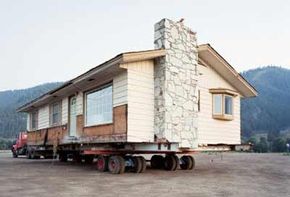Planning a House Move
Most of the work of moving a house actually happens before equipment arrives on the property. House moving usually requires an intensive planning and coordination stage. You'll have to work with local planning departments to ensure the move is allowable and to obtain building permits for both the old and new sites. Inspectors may have to examine the structural integrity of the house, and contractors may have to create the new foundation. Local or state departments of transportation will have to approve the route for transporting the house.
You'll also need to contact the bank or company that holds a mortgage on the home because they'll need to approve the process. If you need a construction loan to cover the moving costs, your application may take a little longer. Be prepared to explain the process to the lender because a bank may get especially nervous hearing about its investment being pulled down the road.
Advertisement
A professional house mover can help you jump through all these hoops. House moving is usually conducted by experienced professionals because they have the proper equipment and structural expertise to keep the home safe. You can search for a house moving company in your area by consulting the International Association of Structural Movers' database of members.
A house mover will help you with the engineering calculations that go into deciding how to move a home, as well as let you know if moving a home makes good financial sense. The structure in question, the route of the move and the new site must be carefully considered when planning a move.
Before calling the house mover, have the following information handy:
- the width, length and height of your home and
- how the house was built, which will help to determine how much the home might weigh.
Generally, a brick home is more expensive to move than a wooden one, and larger homes are more expensive than smaller one-story buildings. Home movers can pick up just about any building, including giant mansions, so this information will help you determine if the house move is worthwhile financially.
You'll also need to gather blueprints or planning documents for the home to provide information about the structural elements of the home, such as the foundation and support beams. This information will help the mover determine what structural support the home will need during the move. The mover will also want to know if you intend to take along any additions, like garages or porches. In most cases, these additions can be moved at the same time if they're supported properly. Brick structures such as fireplaces and chimneys can sometimes be moved, although their weight will add to the overall moving cost. Some builders recommend having them removed and re-bricked at the new home.
Home movers will usually visit the home in person to help figure out these details, but they're going to want to see more than just the structure. The route the house will take is an important factor in the feasibility of the move…and one of the major drivers of cost. To learn about mapping your route and other factors that affect house moving costs, go to the next page.
